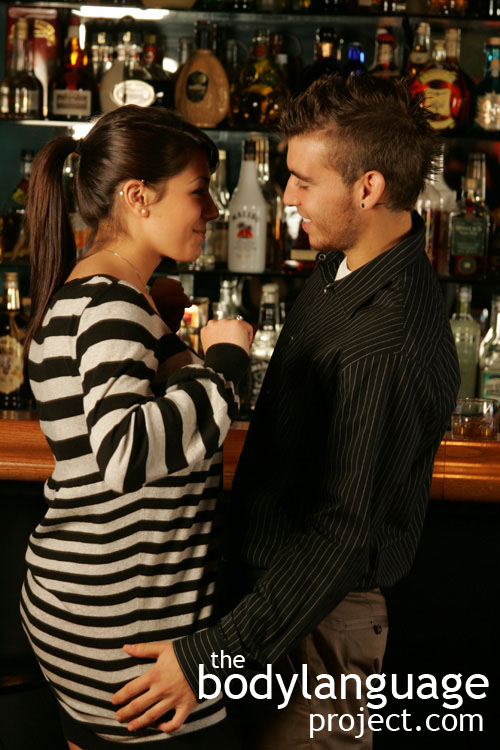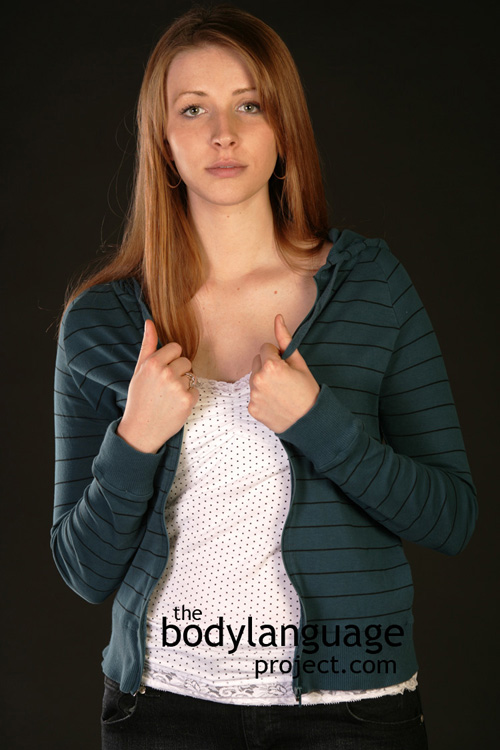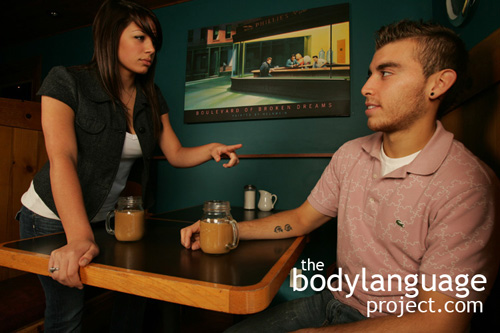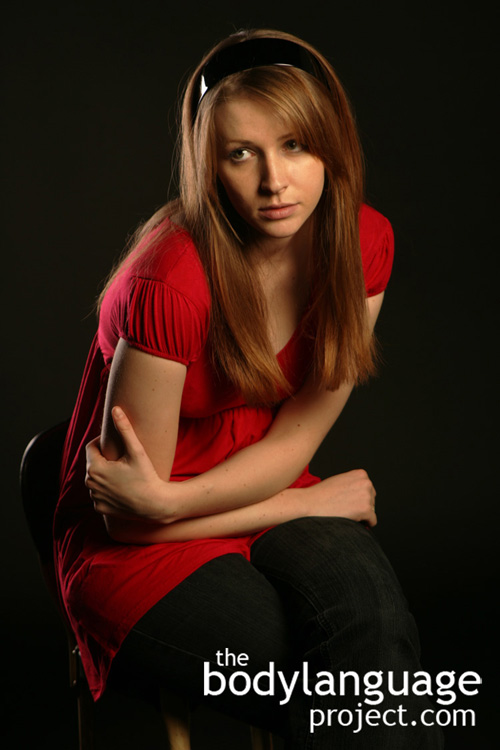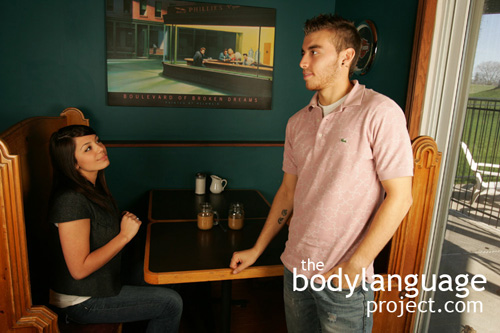Body Language of The Bow and Body Bend
Synonym(s): Kowtow (Chinese), b) Standing Fetal Position (when due to pain), Prostration.
Description: a) The bow is a gesture done by bending at the waist toward the ground. b) A standing fetal position where the body bends at the waist.
In One Sentence: Bowing is a form of appeasement and also submission which is used to show respect.
How To Use it: Use the bow to show others respect or admiration. This can be done by titling the head down slightly which comes across as shame, or by lowering the eyes. When both cues are done simultaneously, this signals a desire to placate a higher authority. Lowering the body by bending at the waist can also be used to show that one is not in full spirits. This is read as cowering. When done in the face of authority, this may produce feelings of sympathy rather than aggression. In turn, they may offer care and assistance to try to ‘lift your spirits.’
Context: General.
Verbal Translation: a) “I respect you enough to trust you won’t hit me on the top of my head while I lower my eyes toward the ground.” b) “I’ve been emotionally hurt (in the guts) and feel like I need to crouch over in pain.”
Variant: See Crouching.
Cue In Action: a) When addressing the King, Sir Charles bent at the waist and bowed to show his admiration. b) After missing a crucial putt, Tiger bend over in emotional agony.
Meaning and/or Motivation: a) It is a form of supplication as it lowers the body. It is usually done in front of an audience or high ranking official as a way to accept their gratitude or adulation. The body bend shows others that they respect the authority figure and that they are ready to submit to them and their will.
b) A standing fetal position meant is meant to protect or comfort during emotional stress. The body takes on a smaller position and hunches up in exasperation. When the body bends in this way, it’s trying to appear submissive and create a smaller target preventing a more dominant individual from attacking. We see this type of posture when people are hurt emotionally and it is especially prominent while in a seated position. The body will lean to the side and the arms will fold over the stomach as if the guts were cramped up in pain.
Cue Cluster: b) Normally accompanied by hands coming up to the head and clasping or sometimes cut short as if swatting the air away in disgust.
Body Language Category: Body size reduction, Defensive, Escape movements, Frustration or frustrated body language, Protective reflexes, Emotional body language, Submissive body language.
Resources:
Adams, E.S., Mesterton-Gibbons, M., 1995. The cost of threat displays and the stability of deceptive communication. J. Theor. Biol. 175, 405–421.
Bohns, Vanessa K. and Scott S. Wiltermuth. It Hurts When I Do This (Or You Do That): Posture And Pain tolerance. Journal of Experimental Social Psychology. 2012. 48: 341-345.
http://bodylanguageproject.com/articles/dominant-and-submissive-postures-affects-more-than-public-perception-it-also-affects-felt-pain-and-physical-strength/
Bartholomewn, Morgan E.; Sheri L. Johnson. Nonverbal Dominance Behavior Among Individuals at Risk for Mania. Journal of Affective Disorders. 2014. 159: 133-138.
http://bodylanguageproject.com/articles/failure-to-use-submissive-body-language-linked-to-bipolar-and-mania-study/
Blidstein, Gerald J. The Nonverbal Language of Prayer (review).Shofar: An Interdisciplinary Journal of Jewish Studies. 2007 25(2): 195-196.
Boyson, A. R., Pryor, B., & Butler, J. (1999). Height as power in women. North American Journal of Psychology, 1, 109–114.
Burgoon, J. K., & Hoobler, G. (2002). Nonverbal signals. In M. L. Knapp & J. A. Daly (Eds.), Handbook of interpersonal communication (3rd ed., pp. 240–299). Thousand Oaks, CA: Sage.
Burgoon, J. K., Johnson, M. L., & Koch, P. T. (1998). The nature and measurement of interpersonal dominance. Communication Monographs, 65, 308–335.
Carney, D. R., Hall, J. A., & LeBeau, L. S. (2005). Beliefs about the nonverbal expression of social power. Journal of Nonverbal Behavior, 29, 105–123.
Cashdan, Elizabeth. Smiles, Speech, and Body Posture: How Women and Men Display Sociometric Status and Power. Journal of Nonverbal Behavior. 1998. 22(4): 209-228.
Cunha, U. ; Leduc, M. ; Nayak, U.S.L. ; Isaacs, B.. Why do old people stoop?
Archives of Gerontology and Geriatrics. 1987 6(4): 363-369.
Dunn, Cynthia Dickel. Speaking politely, kindly, and beautifully: ideologies of politeness in Japanese business etiquette training. Multilingua: Journal of Cross-Cultural and Interlanguage Communication. 2013. 32(2): 225(21).
Ellis, L. (1994). The high and the mighty among man and beast: How universal is the relationship between height (or body size) and social status? In L. Ellis (Ed.). Social stratification and socioeconomic inequality (Vol. 2, pp. 93–111). Westport, CT: Praeger Publishers.
Ginsburg, Harvey J. ; Pollman, Vicki A. ; Wauson, Mitzi S. Odom, Richard D. (editor). An ethological analysis of nonverbal inhibitors of aggressive behavior in male elementary school children. Developmental Psychology. 1977 13(4): 417-418.
Kimbrell, G. Relationship of the upright agonistic posture in the foot shock situation to dominance-submission in male C57BL/6 mice. Psychonomic Science. 1969. 16(3): 167-168.
Katza, Carmit; Irit Hershkowitz; Lindsay C. Malloya; Michael E. Lamba; Armita Atabakia and Sabine Spindlera. Non-Verbal Behavior of Children Who Disclose or do not Disclose Child Abuse in Investigative Interviews. Child Abuse & Neglect. 2012. 36: 12-20.
http://bodylanguageproject.com/articles/reading-nonverbal-behaviour-child-abuse-cases-encourage-children-divulge-information-truth-telling
Li Huang, Adam D. Galinsky, Deborah H Gruenfeld and Lucia E. Guillory. Powerful Postures Versus Powerful Roles: Which Is the Proximate Correlate of Thought and Behavior? 2011, Psychological Science; 22(1): 95–102.
http://bodylanguageproject.com/articles/whats-more-powerful-nonverbal-power-or-real-power/
Mehrabian, Albert Holzberg, Jules D. (editor). Inference of Attitudes From the Posture, Orientation and Distance of a Communicator. Journal of Consulting and Clinical Psychology. 1968. 32(3): 296-308.
Mehrabian, Albert Deese, James (editor). Significance of posture and position in the communication of attitude and status relationships. Psychological Bulletin. 1969. 71(5): 359-372.
Matsumoto, D., & Willingham, B. (2006). The thrill of victory and the agony of defeat: Spontaneous expressions of medal winners of the 2004 Athens Olympic Games. Journal of Personality and Social Psychology, 91(3), 568–581.
Mouterde, S. C., Duganzich, D. M., Molles, L. E., Helps, S., Helps, R., & Waas, J. R. (2012). Triumph displays inform eavesdropping little blue penguins of new dominance asymmetries. Animal Behaviour, 83, 605–611.
Malatynska, E.,Knapp,R.J.,2005.Dominant-Submissive Behavior as Models of Mania and Depression. NeuroScience and.Biobehavior .Rev.29(4–5): 715–737, http://dx.doi.org/10.1016/j.neubiorev.2005.03.014.
Meier, B. P., Hauser, D. J., Robinson, M. D., Friesen, C. K., & Schjeldahl, K. (2007b). What’s ‘up’ with God?: Vertical space as a representation of the divine. Journal of Personality and Social Psychology, 93, 699–710.
Meier, B. P., & Robinson, M. D. (2004). Why the sunny side is up: Associations between affect and vertical position. Psychological Science, 15, 243–247.
Meier, B. P., & Robinson, M. D. (2005). The metaphorical representation of affect. Metaphor and Symbol, 21, 239–257.
Meier, B.P., Robinson, M.D., & Caven, A.J. (in press). Why a big mac is a good mac: Associations between affect and size. Basic and Applied Social Psychology.
Melamed, T. (1992). Personality correlates of physical height. Personality and Individual Differences, 13, 1349–1350.
Middleton, W. C., &Moffett, D. C. (1940). The relation of height and weight measurements to intelligence and to dominance-submission among a group of college freshmen. Research Quarterly of the American Association for Health, Physical Education, and Recreation, 11, 53–59.
Montepare, J. M. (1995). The impact of variations in height on young children’s impressions of men and women. Journal of Nonverbal Behavior, 19, 31–47.
Matsumura, Shuichi ; Hayden, Thomas J. When should signals of submission be given?–A game theory model. Journal of Theoretical Biology. 2006. 240(3): 425-433.
Morris, Desmond (1994). Bodytalk: The Meaning of Human Gestures (New York: Crown Publishers).
Prieto, A. G., & Robbins, M. C. (1975). Perceptions of height and self-esteem. Perceptual and Motor Skills, 40, 395–398.
Park, Lora E.; Lindsey Streamer; Li Huang and Adam D. Galinsky. Stand Tall, But Don’t Put Your Feet Up: Universal and Culturally-Specific Effects of Expansive Postures On Power. Journal of Experimental Social Psychology. 2013; 49: 965–971.
http://bodylanguageproject.com/articles/are-expansive-postures-of-power-universal-or-cultural/
Pitterman, Hallee ; Nowicki Jr, Stephen. A Test of the Ability to Identify Emotion in Human Standing and Sitting Postures: The Diagnostic Analysis of Nonverbal Accuracy-2 Posture Test (DANVA2-POS). Genetic, Social, and General Psychology Monographs. 2004. 130(2): 146-162.
Richards, Lynne ; Mcalister, Laurie. Female Submissiveness, Nonverbal Behavior, and Body Boundary Definition. The Journal of Psychology. 1994 128(4): 419-424.
Riskind, John H. Manis, Melvin (editor). They stoop to conquer: Guiding and self-regulatory functions of physical posture after success and failure. Journal of Personality and Social Psychology. 1984 47(3): 479-493.
Rule, Nicholas, O.; Reginald B. Adams Jr.; Nalini Ambady and Jonathan B. Freeman. Perceptions Of Dominance Following Glimpses Of Faces And Bodies. Perception. 2012; 41: 687-706 doi:10.1068/p7023
http://bodylanguageproject.com/articles/people-can-read-dominance-split-second
Robinson, Michael D. ; Zabelina, Darya L. ; Ode, Scott ; Moeller, Sara K. The vertical nature of dominance-submission: Individual differences in vertical attention. Journal of Research in Personality. 2008. 42(4): 933-948.
Schubert, T. W. (2005). Your highness: Vertical positions as perceptual symbols of power. Journal of Personality and Social Psychology, 89, 1–21.
Schwartz, B., Tesser, A., & Powell, E. (1982). Dominance cues in nonverbal behavior. Social Psychology Quarterly, 45, 114–120.
Stepper, S., & Strack, F. (1993). Proprioceptive determinants of emotional and nonemotional feelings. Journal of Personality and Social Psychology, 64, 211–220.
Scarpa, Stephano; Alessandra Nart; Erica Gobbi and Atillo Carraro. Does Women’s Attitudinal State Body Image Improve After One Session Of Posture Correction Exercises? Social Behavior and Personality. 2011; 39(8): 1045-1052.
Sturman, Edward D. Involuntary Subordination and Its Relation to Personality, Mood,
and Submissive Behavior. Psychological Assessment. 2011. 23(1): 262-276 DOI: 10.1037/a0021499
http://bodylanguageproject.com/articles/nonverbal-submission-men-women-depression-critical-examination-use-disuse-submission/
Schenkel, Rudolf. Submission: Its Features and Function in the Wolf and Dog. American Zoologist. 1967. 7(2): 319-329.
Tracy, J. L., & Matsumoto, D. (2008). The spontaneous expression of pride and shame: Evidence for biologically innate nonverbal displays. Proceedings from the National Academy of Sciences, 105(33), 11655–11660.
Tracy, J. L., & Robins, R. W. (2007). The prototypical pride expression: Development of a nonverbal behavior coding system. Emotion, 7(4), 789–801.
Tiedens, Larissa Z ; Fragale, Alison R. Power moves: complementarity in dominant and submissive nonverbal behavior. Journal of personality and social psychology. 2003. 84(3): 558-68.
Tracy, J. L., & Robins, R. W. (2004). Show your pride: Evidence for a discrete emotion expression. Psychological Science, 15, 194–197.
Weisfeld, Glenn E. and Jody M. Beresford. Erectness of Posture as an Indicator of Dominance or Success in Humans. Motivation and Emotion. 1982. 6(2): 113-130.
http://bodylanguageproject.com/articles/body-language-cues-dominance-submission-children/
Walsh, Joseph ; Eccleston, Christopher ; Keogh, Edmund. Pain communication through body posture: The development and validation of a stimulus set. Pain. 2014. 155(11): 2282-2290.
Welker, Keith M. ; Oberleitner, David E. ; Cain, Samantha ; Carré, Justin M. Upright and left out: Posture moderates the effects of social exclusion on mood and threats to basic needs. European Journal of Social Psychology. 2013 43(5): 355-361.


